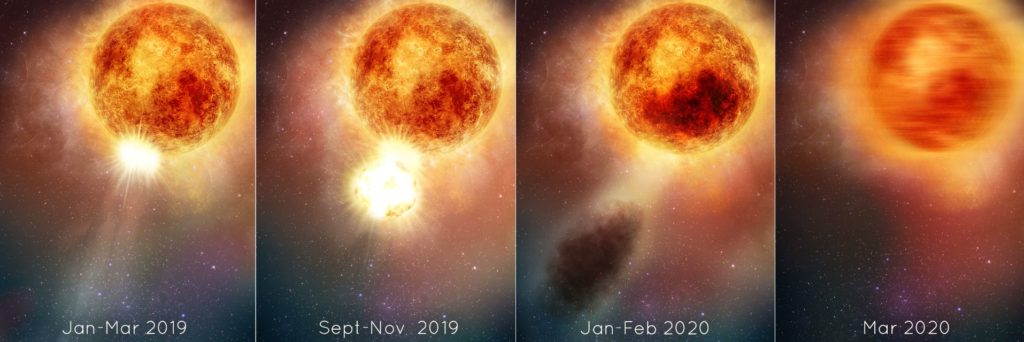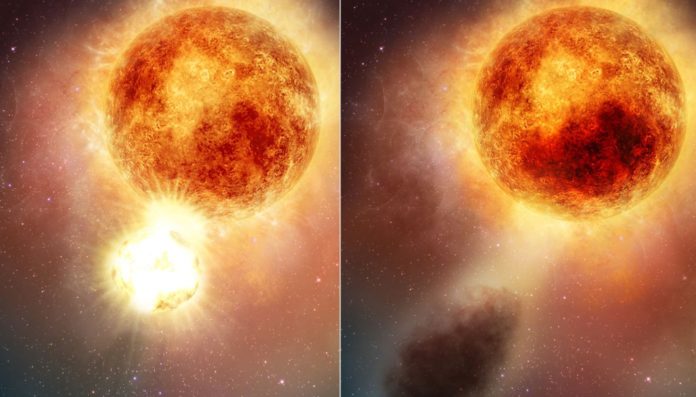Betelgeuse is a beautiful, ruby-red, glimmering star located on the upper right shoulder of the winter constellation Orion the Hunter.
However, astronomers recognize it as a pulsating monster with a 400-day heartbeat when observed up close.
This old star is a supergiant because of its astounding expansion to a diameter of almost 1 billion miles. It would extend to Jupiter’s orbit if it were positioned at the center of our solar system.
The star will eventually undergo a supernova explosion. When this occurs, it will be momentarily visible in the midday sky from Earth. But before the big explosion, there are many of fireworks happening right now.
Using Hubble and other observatories, astronomers determined that the star blasted off a large portion of its visible surface in 2019.
This has never been observed on a star before. Mass ejections of the corona, our Sun’s outer atmosphere, occur often.
However, these events are magnitudes weaker than those observed on Betelgeuse. The first hint occurred in late 2019, when the star abruptly dimmed.
The ejected surface cooled and a huge cloud of obscuring dust emerged. Now, astronomers have put together a possible explanation for the disruption. And the star is still healing; the photosphere is regenerating.
And the interior is vibrating like a bell struck with a sledgehammer, disturbing the natural cycle of the star. Although the gigantic star is unlikely to explode anytime soon, scientists may still be astounded by its late-life movements.
Astronomers have determined through studying data from NASA’s Hubble Space Telescope and a number of other observatories that the bright red supergiant star Betelgeuse virtually blew its top in 2019, losing a significant portion of its visible surface and creating a massive Surface Mass Ejection (SME). This is something that a normal star has never done before.
In a phenomenon known as a Coronal Mass Ejection, our sun periodically throws out portions of its flimsy outer atmosphere, the corona (CME). However, the Betelgeuse SME ejected 400 billion times more mass than an average CME!
The monstrous star is still regaining its strength after this terrible disruption. The interior of Betelgeuse is currently sort of bouncing, according to Andrea Dupree of the Center for Astrophysics | Harvard & Smithsonian in Cambridge, Massachusetts.
These new discoveries provide information on how red stars lose mass toward the end of their lives when their nuclear fusion furnaces exhaust, leading to their eventual explosion as supernovae. Their fate is highly impacted by the degree of mass loss.
But Betelgeuse’s strangely spoiled behavior isn’t proof that the star is going to blow up soon. So the mass loss event is not always a sign that an explosion is about to happen.
Dupree is now piecing together the star’s petulant conduct before, after, and during the eruption into a coherent account of a never-before-seen gigantic convulsion in an old star.
This includes new data from the STELLA robotic observatory, the Fred L. Whipple Observatory’s Tillinghast Reflector Echelle Spectrograph (TRES), NASA’s Solar Terrestrial Relations Observatory spacecraft (STEREO-A), NASA’s Hubble Space Telescope, and the American Association of Variable Star Observers (AAVSO).
Dupree says Hubble data solved the mystery.
“We’ve never before seen a huge mass ejection of the surface of a star,” remarks Dupree.
“We are left with something going on that we don’t completely understand.”
According to the researcher, “It’s a totally new phenomenon that we can observe directly and resolve surface details with Hubble. We’re watching stellar evolution in real time.”
It is possible that the massive outburst in 2019 was triggered by a convective plume, wider than a million miles, rising from the star’s interior.
It caused shocks and pulsations that blew the piece of photosphere off, leaving the star with a large cool surface area under the dust cloud made by the piece of photosphere cooling down. Betelgeuse is having a hard time getting better after being hurt.

The fragmented photosphere, which was roughly several times as heavy as our Moon, flew off into space, cooled, and formed a dust cloud that obscured the star from Earth-based observers.
Even backyard watchers who watched the star’s brightness change were able to easily detect the fading, which started in late 2019 and continued for a few months. Betelgeuse, one of the brightest stars in the sky, may be easily located in Orion’s right shoulder.
The supergiant’s 400-day pulsation rate has disappeared, which is even more amazing. Astronomers have been measuring this rhythm for about 200 years, observing changes in Betelgeuse’s brightness variations and surface motions. Its disruption demonstrates the blowout’s intensity.
Dupree hypothesizes that the convection cells inside the star, which are responsible for the regular pulsation, may be sloshing around like an unbalanced washing machine tub. The surface is still bouncing like a dish of gelatin dessert as the photosphere rebuilds itself, according to TRES and Hubble spectra, even if the outer layers appear to be returning to normal.
It is true that our Sun experiences coronal mass ejections that blast off bits of its outer atmosphere, but scientists have never seen such a big portion of a star’s visible surface blown into space. For this reason, it is possible that coronal mass ejections and surface mass ejections are two distinct phenomena.
Betelgeuse has grown to such a size that if it were to take the place of the Sun as the primary star of our solar system, its surface would stretch beyond Jupiter’s orbit. In 1996, Dupree utilized Hubble to distinguish between hot patches on the star’s surface. It was the first time a star other than the Sun has been directly imaged.
The ejected material may be visible to NASA’s Webb Space Telescope as it continues to move away from the star in infrared light.
Image Credit: Getty
You were reading: NASA’s Hubble Captures Something Strange Never Seen Before In A Normal Star
